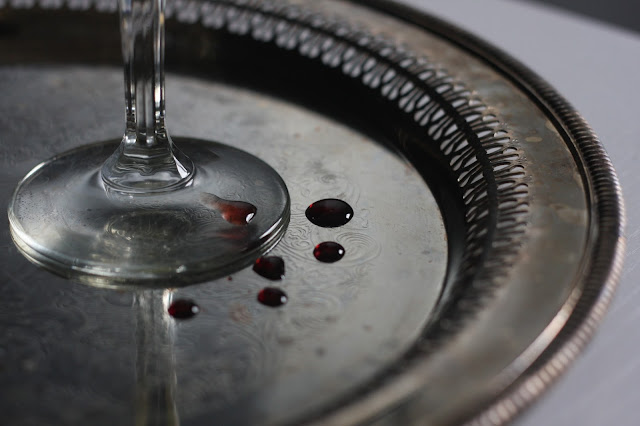When it comes time for a Halloween cocktail, you don't need to look any further than the classics. Flip through any good cocktail menu and you will find some excellent libations with some thoroughly macabre names: Death in the Afternoon, Blood and Sand, Last Word, Zombie... the list goes on. But my personal favorite has to be the Corpse Reviver #2.
I've been meaning to make a Corpse Reviver #2 for the blog for a while, so Halloween seems like the perfect excuse. That said, this is a cocktail for any time of year (sans cherry juice blood, of course). If you're wondering what corpse it is supposed to revive, I'm afraid to say that it's you - the gruesome name is actually a nod to the fact that this cocktail was invented as a hangover cure.
This sour, citrusy cocktail is made with equal parts gin, lemon, Lillet, and triple sec. A wash of absinthe in the glass gives it a delightful hint of anise and a slight eerie green tint. I decided to use Kina L'Aero d'Or instead of Lillet, which gave the cocktail an intriguingly bitter finish - a different experience than with Lillet, but something I definitely recommend trying if you have a bottle. A bit of juice from my jar of Luxardo cherries, slightly reduced in a saucepan, made a spooky, bloody garnish.
History: The fact that this cocktail is called the Corpse Reviver #2 immediately suggests that there is at least one other Corpse Reviver floating around, and that’s true - the Corpse Reviver #1, sometimes just called a Corpse Reviver, made with Cognac, apple brandy or Calvados, and sweet vermouth. Both of these recipes date back to the publication of The Savoy Cocktail Book in 1930, but the idea of a Corpse Reviver has been around a lot longer than that.
Prior to 1930, the term likely didn't refer to a specific cocktail at all; it was rather a catch-all term for a cocktail consumed to cure a bad hangover. Everyone had their own recipe. The earliest mention of a Corpse Reviver is in Punch magazine in 1861, in a brief article entitled “A Smash for a Sensationalist,” a humorous piece about the Trent Affair that I confess I have some difficulty really understanding. But it ends by describing a hangman who “expectorated twice with a marked gaiety of manner, and after liquoring up a Sling, a Stone Wall, and a Corpse-Reviver, he merrily danced forth into the middle of the room and sang a pleasant little song….”
The earliest printed recipe for a Corpse Reviver comes from 1871, in The Gentleman's Table Guide by E. Ricket and C. Thomas. It calls for a 1:1 mixture of brandy and maraschino and two dashes of Boker's bitters, served in a wine glass. The 1903 Steward's Handbook and Guide to Party Catering by Jessup Whitehead has a different recipe, calling for "a long, thin liqueur-glass filled with equal portions noyeau, maraschino and yellow chartreuse, one on top of the other without mixing them; to be taken off with one draught." Here I presume that noyeau is an almond liqueur like Crème de Noyeaux, which makes this a very different cocktail from any of Corpse Revivers above (and one that seems more likely to cause a hangover than cure one).
The two recipes that remain well-known today were popularized by Harry Craddock in The Savoy Cocktail Book. I don't think it's known whether he developed the recipes himself or not, but many of the cocktails in the book were his invention. #2 has stood the test of time better than #1, and is certainly better known.
Corpse Reviver #2
3/4 oz. gin
3/4 oz. Lillet, Cocchi Americano, or Kina L'Aero D'Or
3/4 oz. Cointreau or triple sec
3/4 oz. lemon juice
Absinthe rinse (I used Herbsaint)
Combine gin, Lillet, triple sec, and lemon juice in a shaker with ice. Shake until chilled. Wash a coupe with absinthe and strain the cocktail into the coupe.
Try as a hangover cure if you want, but take care; Harry Craddock notes that "Four of these taken in swift succession will unrevive the corpse again."
Recipe from The Savoy Cocktail Book. Lots of this history came from an article by Cara Strickland for Tales of the Cocktail.
Try as a hangover cure if you want, but take care; Harry Craddock notes that "Four of these taken in swift succession will unrevive the corpse again."
Recipe from The Savoy Cocktail Book. Lots of this history came from an article by Cara Strickland for Tales of the Cocktail.







No comments:
Post a Comment